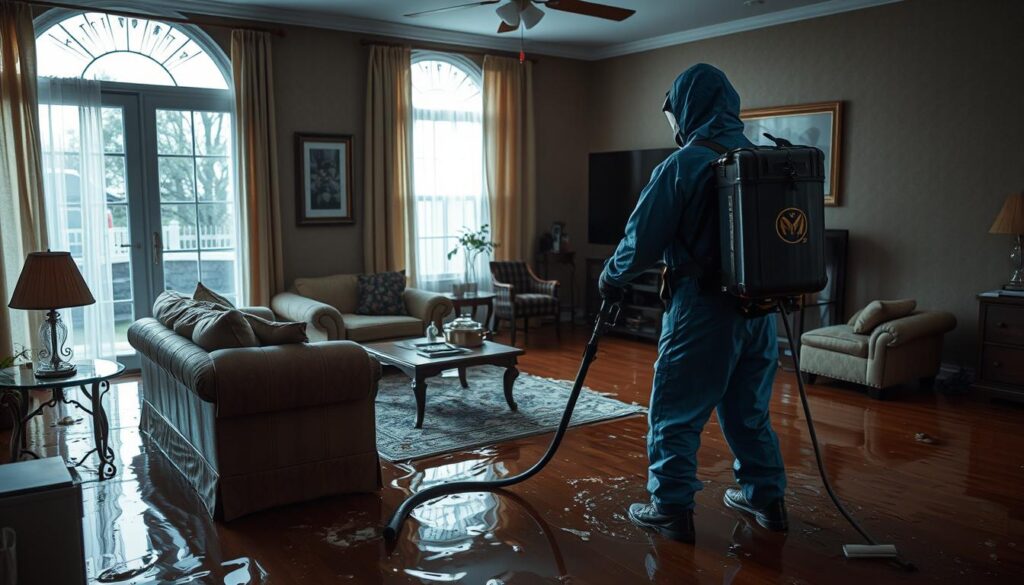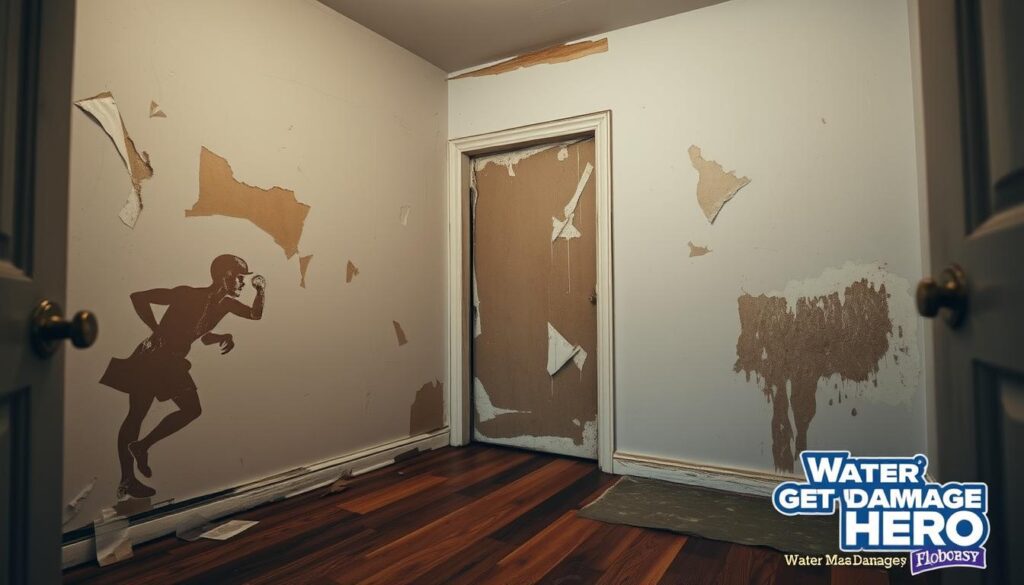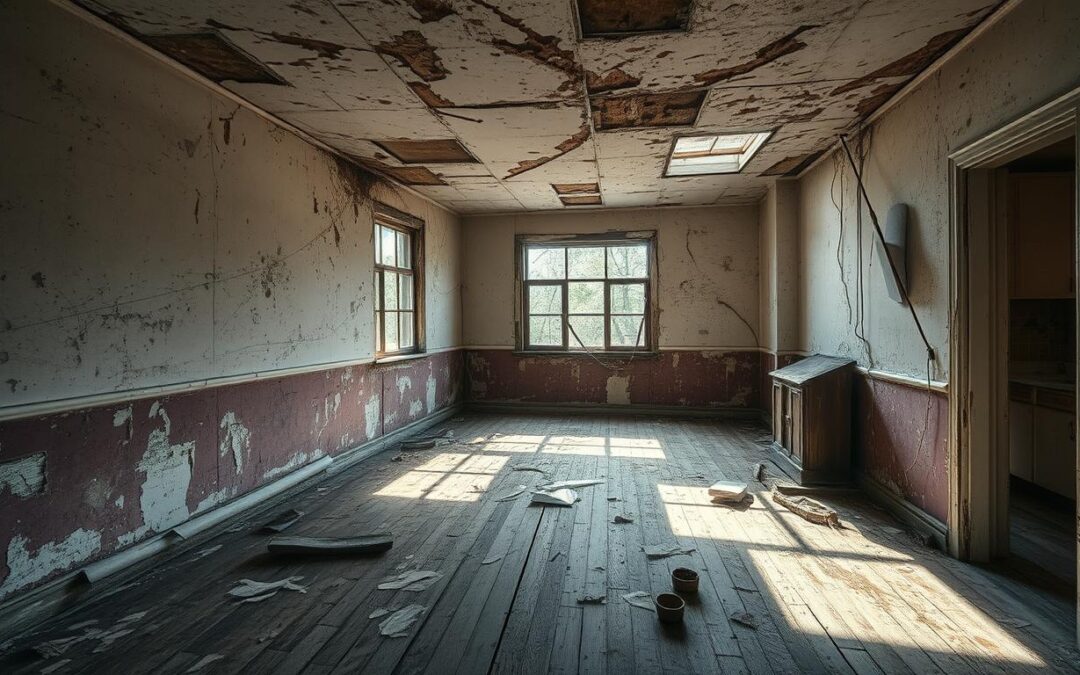When we think of water damage, we often picture a flooded basement or a leaky roof. But water damage is more than just a mess1. It’s a serious issue that can harm your home, health, and wallet. Knowing the true meaning of water damage is key to protecting your home.
Water damage can come from many sources, like burst pipes or heavy storms1. The damage can be severe, causing structural problems and mold growth. These issues can make your home unsafe. No matter the size of the problem, you need to act fast and get professional help to fix it.
Key Takeaways
- Water damage can be caused by a variety of issues, including burst pipes, plumbing problems, heavy storms, and flooding.
- The resulting damage can be severe, leading to structural issues, mold growth, and other problems that can threaten the safety and integrity of your home.
- Understanding the true meaning of water damage is crucial in taking the necessary steps to protect your home.
- Prompt attention and professional intervention are essential in addressing water damage to prevent further escalation.
- Homeowners should be aware of the signs of water damage and take proactive measures to mitigate the risk.
Understanding Water Damage: Definition and Causes
Water damage is a common problem for homeowners. It can happen from many sources inside and outside the home. Knowing what causes water damage helps prevent and reduce its harm.
What Causes Water Damage?
Water damage often comes from plumbing issues. This includes burst pipes, leaking appliances, or faulty plumbing systems. Studies reveal that plumbing leaks waste about 10,000 gallons of water yearly for each home2.
A small pipe crack can leak up to 250 gallons daily2. Broken pipes rank second to hurricanes in damaging homes and claims, with an average of $50,000 per claim2.
Water Damage from Storms or Rain
Heavy storms, rain, or flooding can also cause water damage. The National Flood Insurance Program defines a flood as when two or more acres of land or properties are flooded3. Flood water comes from nature and affects multiple properties, while water damage happens before it touches the ground3.
Flood insurance is different from water damage insurance. Water damage is usually covered by homeowners insurance, but flood insurance is needed for specific cases3.
The damage’s severity depends on where and how long the water stays. The IICRC s500 2016 update classifies water damage into four classes. Class 1 affects less than 5% of a room, while Class 4 needs special drying2. Materials can grow harmful microbes if their moisture content is below 15%2.
Preventing water damage is key. Regular plumbing checks and being ready for disasters can save you money. Knowing the causes of water damage is the first step to protect your home and investment.
What is the meaning of water damage?
Water damage happens when materials or structures get ruined by water4. It can cause things to warp, swell, change color, or grow mold. Knowing what water damage is helps us fix it and stop it from getting worse.
There are three types of water damage: Category 1 (clean water), Category 2 (gray water), and Category 3 (black water)4. Category 3 is the worst because it can have harmful stuff in it.
| Water Damage Category | Description |
|---|---|
| Category 1 | Clean water from a broken pipe or a leaking faucet |
| Category 2 | Gray water from washing machines, dishwashers, or showers |
| Category 3 | Black water from sewage, flooding, or stagnant water |
Leaks or burst pipes are common causes of water damage4. Natural disasters like hurricanes and floods can also cause a lot of damage4. Other reasons include bad roofing, HVAC problems, and clogged gutters4.
Finding out how long water damage has been there can be hard. But, signs like mold, water stains, and musty smells can help4. Getting help from experts like PuroClean of Wilton | Ridgefield is key to fixing water damage well in homes and businesses4.
Distinguishing Water Damage from Flood Damage
Water can cause different types of damage to properties. Water damage and flood damage might seem alike at first glance. But, knowing the differences is key to figuring out the right insurance and how to fix things.
What Constitutes Flood Damage?
Flood damage happens when water covers two or more acres of land or properties. It’s usually caused by heavy rain, storm surges, or when water overflows5. This damage is bigger and more widespread than water damage, which includes things like burst pipes5.
The National Flood Insurance Program (NFIP) clearly explains what flood damage is5. While water damage and flood damage can sometimes happen together, like during a storm, the main difference is in how much and where the water comes from5.
Standard homeowners insurance often doesn’t cover flood and water damage well. You might need extra insurance, like flood insurance56. Insurance can be tricky, so it’s a good idea to check your policy and ask your agent for help if you’re unsure5.
In short, water damage and flood damage are different in scope, cause, and insurance needs. Knowing these differences is important for fixing and recovering from water-related disasters.
Insurance Coverage for Water and Flood Damage
Homeowners insurance usually covers water damage from inside issues like burst pipes or broken appliances7. But, it’s key to know your policy well. Some parts might not be covered, which can really limit what you get7.
What is Covered by Homeowner’s Insurance?
Most homeowner’s insurance covers sudden water damage. This includes burst pipes, overflowing sinks, and broken appliances7. Plumbing failures, like frozen pipes bursting, are common causes of claims7. Always check your policy for any special rules or limits.
Flood Damage Insurance
Flood damage isn’t usually covered by standard homeowner’s insurance8. To protect against flood damage, you need a special flood insurance policy. This is often through the National Flood Insurance Program (NFIP)8. It’s especially important for homes in flood-prone areas.
Not taking care of your home can lead to insurance claims being denied8. Homeowner’s insurance covers sudden water damage but not mold damage unless it was sudden8.
Knowing what your insurance covers and what it doesn’t is crucial. This way, you can make sure your home is well-protected against water and flood damage78.

“About one in 60 insured homes has a property damage claim caused by water damage or freezing each year.”7
Signs of Water Damage in Your Home
Finding water damage in your home is key. It can cause more harm and health risks if ignored. Look out for signs like soft drywall and musty smells. These are clear warnings that need quick action9.
Softened Drywall
Soft drywall is a clear sign of water damage. If walls feel spongy, it means moisture has gotten in. This weakens the wall’s structure9.
Bubbling or Cracked Paint
Paint that bubbles or cracks is another sign. Moisture makes paint peel and blister. This shows there’s a problem underneath10.
Discoloration
Stains on walls or floors are common signs too. Water can cause mold and mildew, leading to ugly stains910.
It’s important to act fast when you see these signs. If you think your home has water damage, get a pro to check it out. They can figure out how bad it is and fix it10.
| Indicator | Description |
|---|---|
| Softened Drywall | Drywall that feels spongy or depressed, indicating moisture absorption and compromised structural integrity. |
| Bubbling or Cracked Paint | Paint that is blistering, peeling, or cracking due to moisture seeping into the walls or ceilings. |
| Discoloration | Staining, mold, or mildew growth on walls, ceilings, or floors, indicating water intrusion. |
By watching for these signs and acting fast, you can avoid more damage. This keeps your home safe and healthy910.
Detecting Hidden Water Damage
Water damage isn’t always easy to spot. Yet, there are signs homeowners should look out for. These signs can show if there’s hidden water damage11. A sudden jump in your water bill might mean a hidden leak. Also, any water pooling around your home is a warning sign11.
Musty smells and mold growth are other signs. They show water damage, even if you can’t see it11.
Unusually High Water Bill
A sudden spike in your water bill could mean a hidden leak11. This could be due to a plumbing problem. Keeping an eye on your water bills can help catch problems early.
Pooling of Water
Water pooling around your home is another sign11. This can happen in basements, crawl spaces, or other areas. It often means a leak or issue that’s causing water to build up. This can damage your home and lead to mold growth.
Microbial Growth and Musty Smells
Musty smells and mold are clear signs of water damage11. These signs mean moisture is building up in your home. This creates the perfect environment for mold to grow.
It’s important to tackle hidden water damage quickly11. Ignoring it can cause more damage and health risks. By spotting these signs early, you can fix the problem before it gets worse.
| Indicator | Description |
|---|---|
| Unexpectedly High Water Bill | A sudden increase in the home’s water usage could signify a hidden leak11. |
| Pooling of Water | Water accumulating in the basement, crawl space, or other areas of the home may indicate a leak or other water-related issue11. |
| Microbial Growth and Musty Smells | The presence of mold, mildew, or a musty odor can be a sign of hidden moisture and water damage11. |

Knowing these signs can help you act fast11. If you suspect water damage, get professional help12.
Water Damage Restoration Process
When water damage hits your home, acting fast is key to avoid more damage and get things back to normal13. Knowing what causes water damage is important. This includes things like air conditioning leaks, natural disasters, and broken appliances14. In the U.S., a water damage emergency happens every 40 seconds, making quick action vital.
The first step in fixing water damage is to find and fix the leak13. Even if it looks like everything is fine, water damage can still be hidden. Look for signs like swollen wood, bad smells, and mold13. Then, experts follow a five-step plan to fix the damage.
- Water Removal: Removing all water and extra moisture is the first step13. This is done with big dehumidifiers and fans13. It’s important to get rid of standing water before drying out the area.
- Cleaning and Disinfection: If the water is really dirty, surfaces need to be cleaned with special solutions13.
- Drying and Dehumidification: The area is dried and treated to stop mold13. The damage level decides how much drying is needed.
- Repair and Reconstruction: Damaged parts like walls or floors are fixed or replaced13. This is especially true after big disasters.
- Monitoring and Verification: The work is checked to make sure everything is dry and safe.
Choosing a certified water damage company is important for a good fix14. They use special tools and solutions to fix the damage14. There are different companies for different needs, like fixing roofs or cleaning carpets.
“Effective water damage restoration is crucial to preventing further harm and ensuring a complete recovery of your property.”
Our Certified Water Damage Restoration Services
At Total Restoration of Texas, we know how fast you need help with water damage restoration services. Our certified team is ready to fix your home or business. We aim to make it like new again15.
Free Water Damage Assessments
Call us, and our experts will come to you for free. They’ll check the damage and tell you how bad it is. Then, they’ll make a plan just for you15.
Certified Water Damage Restoration Technicians
Our team is trained and certified by the IICRC, the top in the field16. You can count on us to fix any water damage, big or small15.
Online Booking for Water Damage Assessments
Booking is easy online. Just pick a time on our website, and we’ll be there. We’re here for you 24/716.
Choose Total Restoration of Texas for your water damage restoration near me needs. We promise top service and satisfaction. Call us for your free assessment today.
Conclusion
Knowing the importance of water damage is key for homeowners. Water damage can cause big problems like structural issues and mold growth if not fixed fast17. Spotting signs like water stains and sudden bill hikes helps homeowners act quickly17.
Fixing water damage fast is critical. Mold can grow in just 24-48 hours, which is bad for health and breathing18.
Preventing water damage is possible with regular checks and using water detection systems18. Quick leak fixes also help. Working with pros who use special tools ensures a good fix18.
By knowing how to handle water damage and taking steps to prevent it, homeowners keep their homes safe and healthy171819.
The best way to deal with water damage is to catch it early and act fast. This protects homes, health, and overall well-being171819.
FAQ
What is the definition of water damage?
What causes water damage?
How can I identify water damage in my home?
What is the difference between water damage and flood damage?
What does homeowner’s insurance cover for water damage?
What is the water damage restoration process?
What services do water damage restoration companies provide?
Source Links
- Water Damage Vs Flood Damage: What’s The Difference?
- Water damage
- Flood Damage vs Water Damage: Know the Difference?
- GOOD Home: How to Tell if Water Damage Is New or Old – Good Morning Wilton
- Water Damage vs. Flood Damage – Harry Levine Insurance
- Water Damage v. Flood Damage: What’s the Difference? – Hilton Head Insurance & Brokerage
- Water Damage Insurance: What It Means, How It Works, Types
- Does Homeowners Insurance Cover Water Damage?
- 14 Signs that There’s Water Damage in a Property You’re Interested in Buying
- Early Signs of Water Damage – Orange Restoration
- How to Detect Hidden Signs of Water Damage in Walls – PuroClean HQ
- What Does Water Damage Look Like? The Signs of Water Damage
- A Guide to Water Damage Restoration Process | SafetyCulture
- The Water Damage Restoration Process Explained
- Water damage is separated into three categories by insurance companies.
- What Is Emergency Water Damage Mitigation & Restoration? | HRS Restoration Services
- Property Restoration | Signs of Residential Water Damage
- Is Water Damage Permanent? Know the Signs
- Understanding the Distinction: Water Damage Mold vs. Water Damage | Greenworks Inspections
